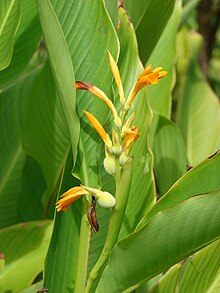Canna jaegeriana
| Canna jaegeriana | |
|---|---|

| |
| Scientific classification | |
| Kingdom: | |
| (unranked): | |
| (unranked): | |
| (unranked): | |
| Order: | |
| Family: | |
| Genus: | |
| Species: | C. jaegeriana
|
| Binomial name | |
| Canna jaegeriana | |
| Synonyms | |
| |
Canna jaegeriana is a species of canna from high altitudes, characterized by a combination of the following characters: generally curved, orange, small (4–7.5 cm long) flowers with free part of staminodes erect, floral bracts mostly caducous, and upper side of leaves often dark brown to black in herbarium material, lower side more or less lanuginose. In addition, the seeds are ellipsoid and relatively small (4–7 × 2–4.5 mm).
It occurs in the Greater Antilles (Dominican Republic, Haiti, Puerto Rico) and tropical South America, north and west of the Amazon Basin (Venezuela, Ecuador, Peru, and Bolivia).
Taxonomy
In the last three decades of the 20th century, Canna species have been categorised by two different taxonomists, Paulus Johannes Maria Maas, from the Netherlands and Nobuyuki Tanaka from Japan. They both agree that this is a separate and distinct species.
References
- Cooke, Ian, 2001. The Gardener's Guide to Growing cannas, Timber Press. ISBN 0-88192-513-6
- Johnson's Gardeners Dictionary, 1856
- Tanaka, N. 2001. Taxonomic revision of the family Cannaceae in the New World and Asia. Makinoa ser. 2, 1:34–43.
External links
- Kew Gardens, Checklist of plant families[permanent dead link]
- Proposal to conserve the name Canna jaegeriana
